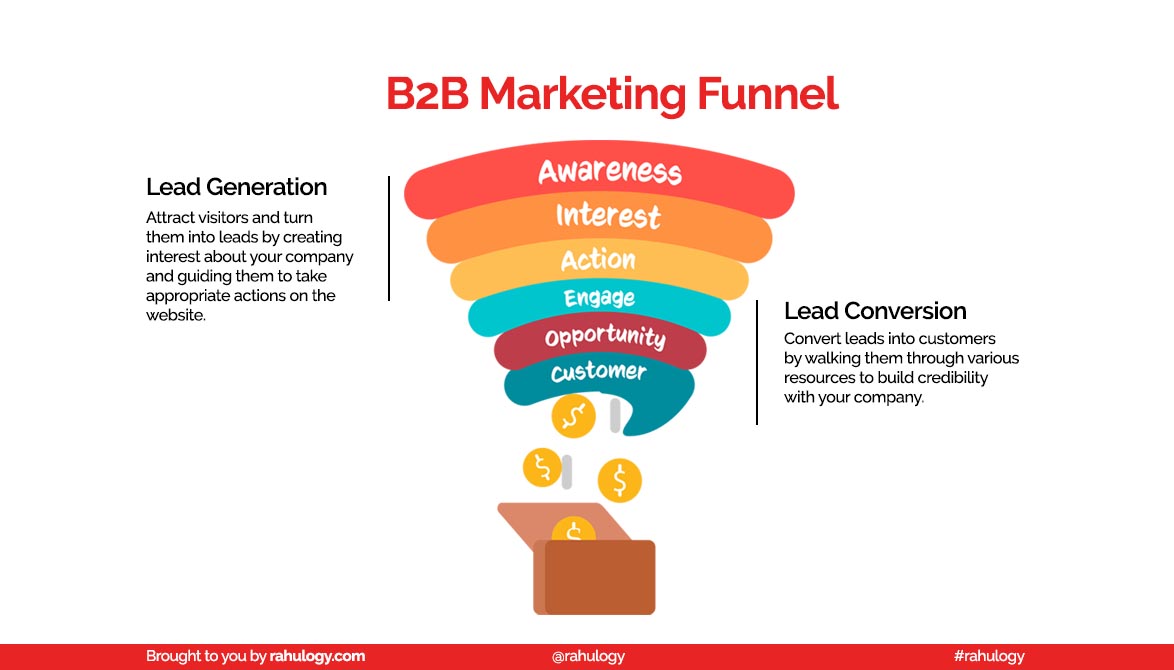A marketing funnel is a way to visualize a potential customer’s journey from an unknown website visitor to becoming a first-time customer for the company.
The B2B marketing funnel comprises lead generation and conversion processes, among which the lead generation process can be automated. However, human interaction is still an essential part of the conversion process. This is because the B2B sales process involves several decision-makers from the lead qualification stage to come upon mutual terms to close the deal.
A typical B2B marketing funnel can be 6 stages as shown below –

Now let’s break it down and see what each stage looks like and its role in the lead conversion.
Stage 1: Awareness
At this stage, you pull all the potential customers into the funnel by creating awareness about the brand, product, and solutions that your company offers.
Your marketing strategy should include anything that enables you to reach new prospects on relevant platforms to create awareness about your product and services. For this, you can leverage paid promotions on social media & search engines for quick results or opt to grow organically.
However, I always recommend including paid and organic promotions for better results. For example, PPC ads on Google with effective SEO can help you not only drive traffic to your website but add the recall factor and brand credibility by ranking top on the result page.
Guest blogging on relevant websites where your target audience spends time staying updated can also be a great idea to create awareness among an already established audience and prospective customers.
Stage 2: Interest
At this stage, you build up interest in the brand among your audience that you attracted initially at the awareness stage.
For this, you can retarget your visitors on social media with more information related to the pages they were exploring on the website during their previous visits.
Social sites like Facebook, Twitter, and LinkedIn offer tools like Facebook Pixels, Twitter Tags, and LinkedIn Insight Tags, respectively, that track the visitors’ activities on your website and enable you to reach them again with targeted ads based on their previous activities.
This way, you can stay connected with them and establish communication with more personalized and relevant information that can help them make better decisions, most preferably in your favor.
Stage 3: Action
At this stage, your objective should be to make your repeat visitors take action on the landing page. A common example includes buttons with compelling copy like “Request a Demo”, “Request a callback” or “Download Now”.
Landing pages play a vital role in lead generation. This is why, your page content, design, and CTAs should be done strategically so that the visitors find the information relevant to their needs and drive them to do what you want them to do on the page.
Once the visitor takes any such action, you have the data that enables you to take the conversation beyond social media and guide them toward the next step and so on until they’re ready to talk to sales.
Stage 4: Engage
Till this stage, you have data of the most prospective consumers, i.e., leads, in your database.
Once a prospect reaches this funnel stage, they are already 57% into the buying process. It means the prospect is considering your company as a viable vendor among other players in the market.
At this stage, keep your leads engaged & delighted with marketing content like whitepapers, blog posts, customer testimonials, case studies, etc. This is typically where the sales team comes into the picture to nurture the most qualified leads. The sales team starts to reach out to them in an effort to attract them into the sales process.
This is the most crucial stage in the funnel because what you do and how you keep your prospects engaged decides how far the conversation can go between both parties.
Stage 5: Opportunity
At this stage, the sales team talks with the leads who showed a high level of engagement in the previous stage to move forward in the buying process.
The sales team tries to establish a one-on-one conversation with such leads by sending them highly focused emails. Also, at this stage, cold outreach becomes more effective as the prospect already knows a lot about the brand and may show interest in taking the conversation forward.
If done properly and the prospect is still considering buying from your company, the sales representative sets up their first meeting and that’s when the “Opportunity” happens.
Stage 6: Customer
Finally, a lead becomes a customer when they have committed to business engagement with your company & the opportunity with them is closed-won.
Now, in B2B, the duration of the journey from the first meeting with the prospects i.e. opportunity to sign the final contract depends on many factors like the number of decision-makers involved, budget constraints, etc. It can be as short as a day & as long as a couple of months.
Always remember, in B2B, you can win only by educating your customers about their problems and the solutions you’re offering in the best possible way, not by keeping them in the dark.
So, make sure that throughout your marketing funnel, you’re providing the best resources to educate your prospect that drives them to the next stage and ultimately become your customer.
